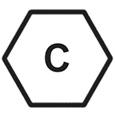ELECTRIC VEHICLE: charging
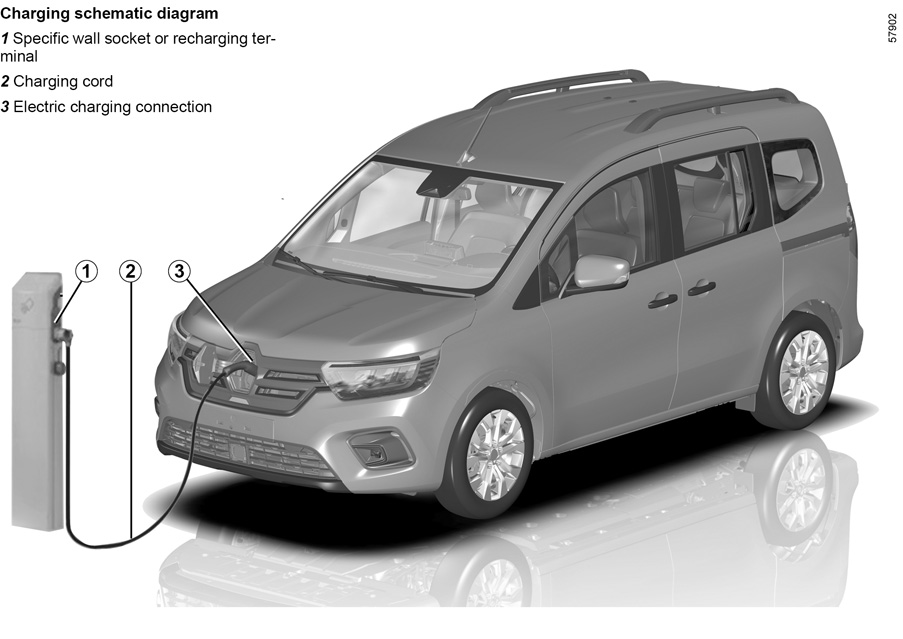
If you have any questions regarding the equipment needed for charging, please ask an authorised dealer.
Important recommendations for charging your vehicle
Please read these instructions carefully. Failure to follow these instructions may lead to a risk of fire, serious injury or electric shocks which could result in death.
Charging
Do not do anything to the vehicle during charging (washing, working in the engine compartment, etc.).
In the event of the presence of water, signs of corrosion or foreign bodies in the charging cord connector or in the vehicle charging socket, do not charge the vehicle. Fire hazard.
Do not attempt to touch the cord contacts, the domestic socket or the vehicle charging socket, or introduce objects into them.
Never plug the charging cord into an adapter, multiple socket or extension lead.
The use of generators is prohibited.
Do not remove or change the vehicle charging socket or the charging cord. Fire hazard.
Do not modify or perform any action on the installation during charging.
In the event of an impact, even slight, against the charging socket or valve, have them checked by an authorised dealer as soon as possible.
Take care of the cord: do not tread on it, immerse it in water or pull on it or let anything knock against it.
Check regularly that the charging lead is in good condition.
In the event of damage to the charging lead (corrosion, browning, cuts, etc.), to the unit or to the vehicle's electrical charging socket, do not use them. Please see an authorised dealer to replace them.
In the event of non-activation of the charging flap locking mechanism and/or unlocking of the vehicle's electric charging socket, please contact an approved dealer.
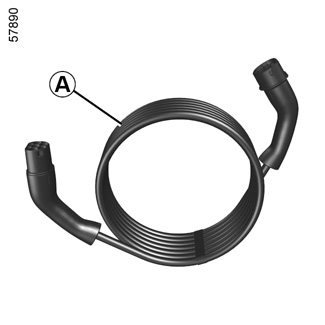
Charging cord A
This lead is specific to your vehicle and designed for connecting to wall sockets or public terminals to enable standard charging of the traction battery.
We recommend that you use a charging cord that enables a standard charge to charge the traction battery.
Each charging lead is stored in the luggage compartment of the vehicle LUGGAGE COMPARTMENT STORAGE SPACE AND FITTINGS.
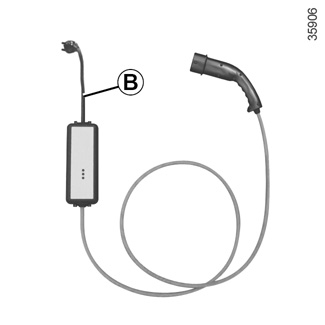
Charging cord B
This cord allows:
- standard charge, on a socket used only for the vehicle (16 A charge);
- occasional charging using a domestic socket (8 A, 10 A charging), for example when you are not at home.
Sockets must be fitted as stated in the instructions in the instructions supplied with the charging cord B.
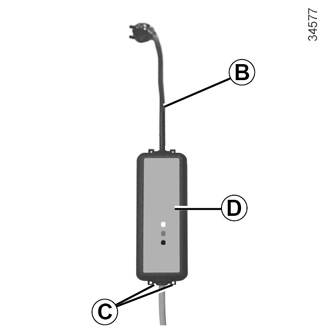
Always read the charging cord instructions carefully before using it B.
Never leave the socket hanging by the cord. Use the hooks C to attach it.
If a charging cable malfunctions during the charging process (red warning light on the unit D), stop charging immediately. Please refer to cord instructions.
Important recommendations for charging your vehicle
Please read these instructions carefully. Failure to follow these instructions may lead to a risk of fire, serious injury or electric shocks which could result in death.
Choice of charging cord
The standard charging cords supplied with the vehicle have been designed specifically for this vehicle. It is designed to protect you against the risks of electric shock that can lead to death or fire.
Do not use with the charging leads of previous vehicles as they are not adapted. For safety reasons, the use of a charging cord not recommended by the manufacturer is strictly forbidden. Failure to follow this instruction can lead to risks of fire or electric shock that can prove fatal. For information on a charging cord suited to your vehicle, please consult an authorised dealer.
Using the charging lead B
Please read the instructions that come with the charging cord carefully to learn about precautions you must take when using the product and the technical specifications required when fitting the socket.
Installation
Power supply systems
Only use charging terminals which conform to the IEC 61851-1 standard and connecting points protected by:
- a type A 30 mA residual differential current system specific to the socket used;
- an overcurrent protection device;
- protection against overvoltage relating to lightning in exposed areas (IEC 62305-4).
Wall socket
Have a special wall socket installed by a qualified professional.
In the case of domestic charging
Have a qualified professional check that each socket to which you will connect the charging cord complies with the standards and regulations in force in your country and that it complies with the specifications described previously in the information on “Power supply systems”.
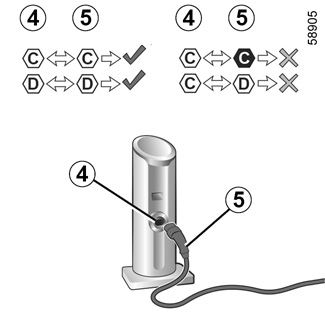
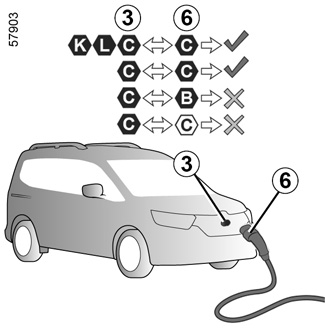
Charging types that conform to European standards
Alternating current (AC)
If the information is displayed on the vehicle charging flap, follow the instructions below.
Before plugging in a charging lead, check that:
- the colour and one of the letters of the inlet socket 4 correspond to the colour and one of the letters on the end 5 of the lead;
- the colour and one of the letters of the inlet socket 3 correspond to the colour and one of the letters on the end 6 of the lead.
Charging type | Alternating current (AC) | |||
|---|---|---|---|---|
Connection | Charging terminal 4/Charging lead 5 | Vehicle 3/Charging lead 6 | ||
Charging types that conform to European standards (for all other cases, please consult an approved dealer). |
|
|
|
|

Charging types that conform to European standards (continued)
Direct current (DC)
If the information is displayed on the vehicle charging flap, follow the instructions below.
Before plugging in a charging lead, make sure that the colour and one of the letters of the inlet socket 3 correspond to the colour and one of the letters on the end 6 of the charging lead.
Charging type | Direct current (DC) | ||||
|---|---|---|---|---|---|
Connection | Vehicle 3/Charging lead 6 | ||||
Charging types that conform to European standards (for all other cases, please consult an approved dealer). |
|
|
|
|
|

Electric charging connection 3
Note: If in a snowy environment, remove snow from the vehicle charging area before plugging in or disconnecting. Snow in the socket may block the insertion of the charging cord plug.
The vehicle is equipped with two charging connections located at the front of the vehicle (depending on the vehicle):
- E socket for charging up to 22 kW;
- F socket for direct current charging.
Note: on vehicles fitted with an 11 kW charger, connecting the charging cable to the E socket and to a 22 kW recharging terminal will enable the vehicle to be charged at a maximum of 11 kW.
Precautions
Avoid charging and parking your vehicle in extreme temperatures (hot or cold).
Under extreme conditions, charging may take several minutes before starting (time required for the traction battery to cool down or warm up).
When the vehicle is parked for more than seven days in temperatures below about -25°C, charging the traction battery can become impossible.
If the vehicle is parked for more than three months with near zero charge, it may become impossible to charge the battery.
To preserve the service life of your traction battery, avoid parking the vehicle for more than one month with high charge, especially when the weather is very hot.
Energy level availability depends on the battery temperature. It may therefore vary between the time the vehicle is stopped and restarted, depending on whether the battery is cold or warm.
Precautions
(continued)
In anticipation of arrival and parking in cold conditions (minus temperatures), if the battery charge level is below approximately 30%, the vehicle must be recharged within approximately four hours after the vehicle is parked.
When arriving in a cold location, the battery temperature will drop and approach the exterior temperature.
In such a situation, the battery’s useful capacity (available energy level) may be reduced significantly to the extent that it will not be possible to start the vehicle again.
Note: the useful capacity will be recovered during the next journey if the battery temperature increases sufficiently.
Favour charging the traction battery after driving and/or in mild temperatures. Otherwise, charging may take a longer period of time or even become impossible.
Advice
- In high temperatures, try to park and recharge the vehicle in a shaded/covered location;
- charging can be performed in the rain or snow;
- activating the air-conditioning increases the charging time required.
In the absence of any protection against overvoltage, we recommend that you do not recharge the vehicle in stormy weather (lightning, etc.).
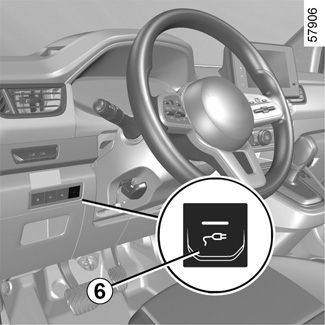
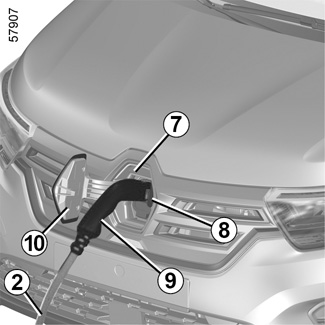
Recharging the traction battery
Vehicle stationary, ignition off:
- take the charging cord located in the boot of your vehicle;
- press the switch 6 or, depending on the vehicle, press the electric charging socket unlocking button on the card CARD: general information, to unlock the charging flap 10;
- open valve 8;
- plug in the end of the cord to the power supply;
- grab the handle 9;
- plug in the vehicle cord. The warning light 7 flashes in yellow;
- after you hear a locking click, check that the charging cord is properly plugged in. To check the locking, pull gently on the handle 9.
Do not use the charging flap 10 to suspend the charging cord 2 while recharging the vehicle.
The charging cord is automatically locked with the vehicle. This will make it impossible to unplug the cord from your vehicle.
During charging, the warning light 7 flashes in blue.
For direct current charging (DC), the length of the charging cable between your vehicle and the charging terminal must not exceed 30 metres.
If there is any doubt about the length of the cable, consult the owner of the DC charging terminal.
Make sure you fully uncoil the charging cord to limit its heating.
Do not use an extension lead, multiple socket or adapter.
Fire hazard.
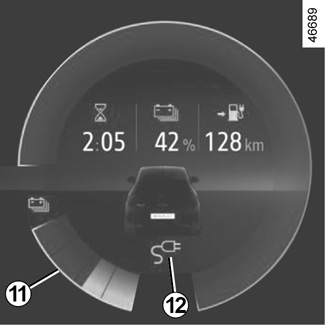
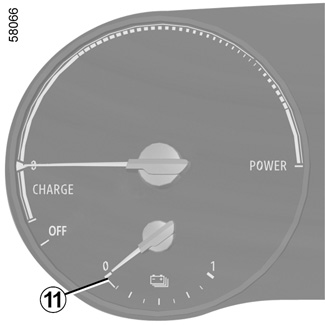
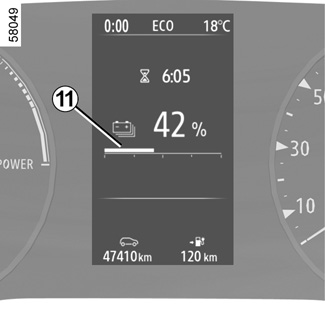
When charging starts, the following information is displayed on the instrument panel:
- the energy level on the battery warning light 11;
- the battery refill rate;
- an estimate of the remaining charging time (this is not displayed after about 95% charge);
- depending on the vehicle, the warning light 12 indicates that the vehicle is connected to a power supply;
- your vehicle range will vary according to the charge level.
The traction battery charging time depends on the amount of energy remaining and the power delivered by the charging terminal. The information is displayed on the instrument panel during charging DISPLAYS AND INDICATORS.
Note: under certain conditions, the actual charging time may be longer than the charging time displayed on the instrument panel. This depends on:
- the quality of the electrical network;
- the initial charge level;
- the exterior temperature is too cold;
- ...
In the event of a problem with the charging cable, we recommend that you replace it with a cable that is identical to the original. Consult an approved dealer.
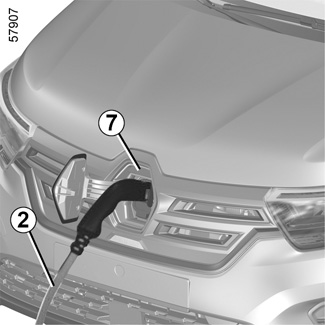
The display on the instrument panel disappears after a few seconds. It reappears when the doors are unlocked.
Once charging is complete, the warning light 7 appears continuously in green.
You do not need to wait until the charge is at reserve levels to recharge your vehicle.
Operating faults
When the warning light 7 flashes in red:
- disconnect the cable 2 from the socket 3 and from the power supply according to the procedure described on the following page;
- re-connect the cable 2 to the same supply source or to one nearby.
If the 7 warning light continues to flash in red, contact an approved dealer.
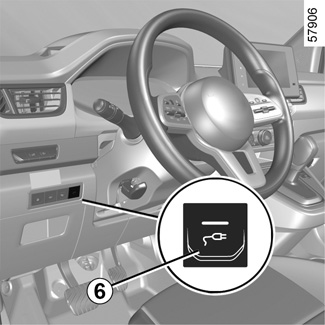
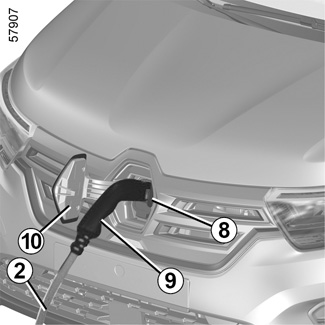
Precautions to take when removing from the socket
- Press the switch 6 or, depending on the vehicle, press the electric charging socket unlocking button on the card CARD: general information, to unlock the charging flap and release the charging cable 2 from the vehicle;
- grab the handle 9;
- unplug the charging lead 2 from the vehicle;
- the valve 8 must be closed;
- you must close the 10 charging flap and press on it in order to lock it;
- unplug the lead 2 from the power supply 1;
- store the cable 2 in the luggage compartment.
It is imperative to follow the unplugging steps in order.
Note: immediately after a long charge of the traction battery, the cable may be hot. Please use the handles.
In the event of an unexpected charging interruption (charging fault, faulty recharging terminal, etc.), disconnect the cable 2 and ensure that the charging flap is properly closed and locked 10 before attempting to recharge or before starting the vehicle.
After pressing the charging cable unlocking button, you have 30 seconds to unplug it before it locks again.
To avoid disturbing the charging monitoring system, do not install any antistatic strip to the vehicle.
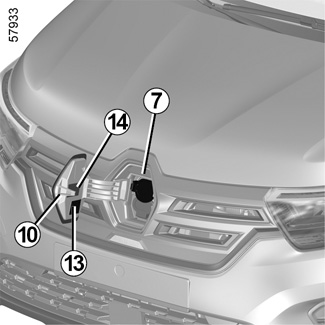
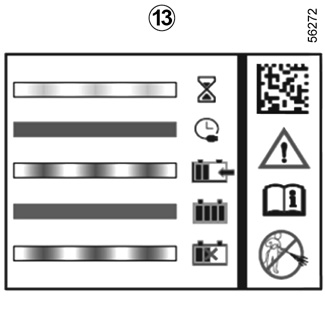
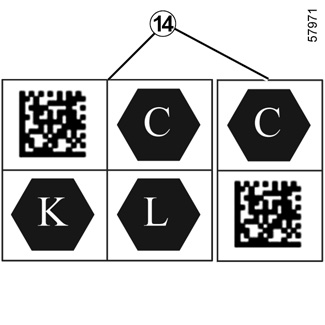
Label 13
The label 13 located on the charging flap 10 displays details on how the charging operation is indicated by the status of the warning light 7:
- flash in yellow: the lead is plugged into the vehicle and the system carries out its checks;
- flashing in blue: charging is in progress;
- illuminated continuously in blue: charge programming is activated;
- illuminated continuously in green: the vehicle is fully charged;
- flashing in red: operating fault.
The label 13 located on the right-hand side reminds you of the following instructions:
- do not wash the charging flap using a high-pressure water jet;
- with the vehicle stationary, the valve and the charging flap can be open;
- when the vehicle is being driven, the valve and the charging flap must be closed;
- open the flap to connect the charging lead;
- close the flap again once disconnected;
- connect to a domestic socket, an alternating current charging terminal or a direct current charging terminal;
- for any information on charging, please consult your vehicle user manual.
Label 14
Depending on the vehicle, one of the 14 labels is located on the charging flap 10.
